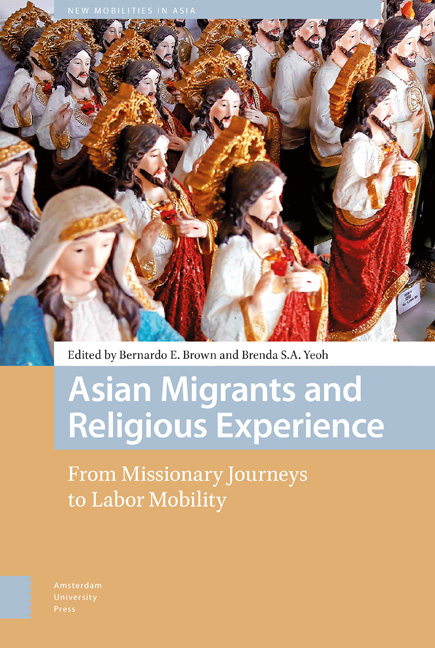Book contents
- Frontmatter
- Contents
- List of Illustrations
- Acknowledgments
- 1 Introduction: Human Mobility as Engine of Religious Change
- Section 1 Mobile Religious Practices
- 2 Saving Yogis: Spiritual Nationalism and the Proselytizing Missions of Global Yoga
- 3 Renewed Flows of Ritual Knowledge and Ritual Affect within Transnational Networks: A Case Study of Three Ritual Events of the Xinghua (Henghua) Communities in Singapore
- 4 Liberalizing the Boundaries: Reconfiguration of Religious Beliefs and Practice amongst Sri Lankan Immigrants in Australia
- Section 2 Transnational Proselytizing
- 5 From Structural Separation to Religious Incorporation: A Case Study of a Transnational Buddhist Group in Shanghai, China
- 6 “10/40 Window”: Naga Missionaries as Spiritual Migrants and the Asian Experience
- 7 Religion, Masculinity, and Transnational Mobility: Migrant Catholic Men and the Politics of Evangelization
- 8 Helping the Wounded as Religious Experience: The Free Burma Rangers in Karen State, Myanmar
- Section 3 Refashioning Religiosity in the Diaspora
- 9 A Multicultural Church: Notes on Sri Lankan Transnational Workers and the Migrant Chaplaincy in Italy
- 10 “Bahala Na Ang Diyos”: The Paradox of Empowerment among Filipino Catholic Migrants in South Korea
- 11 Feeling Hindu: The Devotional Sivaist Esthetic Matrix and the Creation of a Diasporic Hinduism in North Sumatra
- 12 Afterword: What Makes Asian Migrants’ Religious Experience Asian?
- References
- Index
3 - Renewed Flows of Ritual Knowledge and Ritual Affect within Transnational Networks: A Case Study of Three Ritual Events of the Xinghua (Henghua) Communities in Singapore
Published online by Cambridge University Press: 12 December 2020
- Frontmatter
- Contents
- List of Illustrations
- Acknowledgments
- 1 Introduction: Human Mobility as Engine of Religious Change
- Section 1 Mobile Religious Practices
- 2 Saving Yogis: Spiritual Nationalism and the Proselytizing Missions of Global Yoga
- 3 Renewed Flows of Ritual Knowledge and Ritual Affect within Transnational Networks: A Case Study of Three Ritual Events of the Xinghua (Henghua) Communities in Singapore
- 4 Liberalizing the Boundaries: Reconfiguration of Religious Beliefs and Practice amongst Sri Lankan Immigrants in Australia
- Section 2 Transnational Proselytizing
- 5 From Structural Separation to Religious Incorporation: A Case Study of a Transnational Buddhist Group in Shanghai, China
- 6 “10/40 Window”: Naga Missionaries as Spiritual Migrants and the Asian Experience
- 7 Religion, Masculinity, and Transnational Mobility: Migrant Catholic Men and the Politics of Evangelization
- 8 Helping the Wounded as Religious Experience: The Free Burma Rangers in Karen State, Myanmar
- Section 3 Refashioning Religiosity in the Diaspora
- 9 A Multicultural Church: Notes on Sri Lankan Transnational Workers and the Migrant Chaplaincy in Italy
- 10 “Bahala Na Ang Diyos”: The Paradox of Empowerment among Filipino Catholic Migrants in South Korea
- 11 Feeling Hindu: The Devotional Sivaist Esthetic Matrix and the Creation of a Diasporic Hinduism in North Sumatra
- 12 Afterword: What Makes Asian Migrants’ Religious Experience Asian?
- References
- Index
Summary
Abstract
This chapter explores the continuous reinvention and circulation of ritual traditions within the migration from Putian, Fujian, China, to Southeast Asia. It outlines the historical background of the Henghua migration, and explores how migrants transformed their rituals, creating new gender roles and social relations both in Southeast Asia and back in their home region. The mobility of migrants, ritual traditions, and ritual specialists who move across the entire migration network generates complex network effects. Efforts to spread ritual traditions beyond dialect boundaries are also discussed, as is the role of affect within complex, sensory saturated rituals: 1) a universal deliverance rite; 2) a male spirit-medium training session; and 3) female spirit-medium training sessions that have spread across Southeast Asia and back to Putian, China.
Keywords: Southeast Asia, Putian, migration, ritual events
Introduction
This chapter examines the history and ritual events of migrants from the Xinghua region (Putian and Xianyou counties of Fujian, China) in Singapore and Indonesia, in order to explore the ways in which these migrantcommunities transformed their rituals, and in the process extended their rites beyond their own dialect boundaries, while also creating new gender roles and transforming social relations both in Southeast Asia and back in their home region of Putian, Fujian. The continuous reinvention and circulation of tradition has been a prominent feature of Chinese migrant communities in Southeast Asia for centuries. In order to bring out some of the effects of the mobility of migrants, ritual traditions, and ritual specialists, the chapter first outlines the socioeconomic and cultural historical backgrounds of the Chinese migration to Southeast Asia, through an overview of recent historiography and the analysis of local historical sources including temple and lineage records, stone inscriptions, and liturgical manuscripts. The next section of the chapter adopts a multi-sited anthropological method, examining ritual events in different parts of the Xinghua migration to Southeast Asia. Ritual traditions and ritual specialists (spirit mediums, Daoist masters, temple leaders, and members of the migrant ritual community) circulate between these sites, going back and forth from Sumatra to Singapore to Jakarta to Putian, even as these highly regionally specific ritual traditions begin to attract members of other dialect groups in Singapore.
- Type
- Chapter
- Information
- Asian Migrants and Religious ExperienceFrom Missionary Journeys to Labor Mobility, pp. 71 - 100Publisher: Amsterdam University PressPrint publication year: 2018

